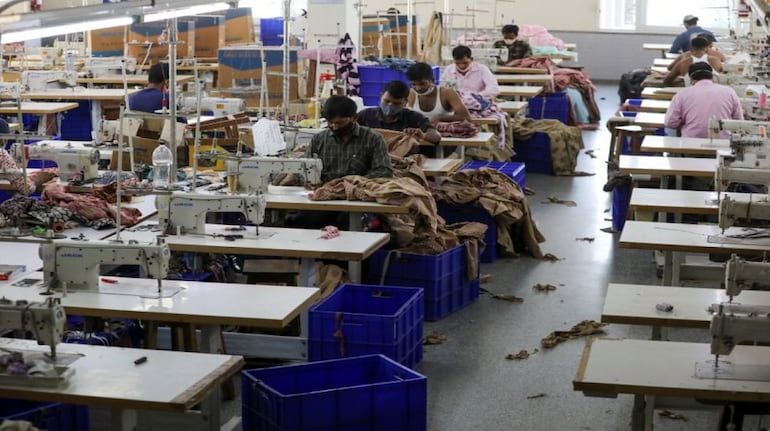



India’s textile industry, which sends nearly 27 percent of its output to the United States, is staring at an uncertain future after US President Donald Trump announced a steep hike in tariffs on Indian goods from 25 percent to a staggering 50 percent.
The move, which takes effect three weeks from August 7, affects several key Indian exports including garments, textiles, gems, leather, and processed foods. For the textile sector in particular, the hike could severely dent order books, compress profit margins, and put thousands of jobs at risk, setting off a cascading effect that may tighten bank credit to the industry.
This is bad news even to banks lending to the textiles industry. Especially after seeing non-performing assets ratio breaching the 9 percent mark in FY24. Data from Reserve Bank of India shows that total bank credit to the textile industry rose from around Rs 2 lakh crore in FY19 to nearly Rs 2.77 lakh crore by March 2025. While that’s a 38 percent increase in absolute terms, the compound annual growth rate (CAGR) works out to just 5.5 percent, a relatively subdued pace compared with other priority sectors such as renewable energy (10-12 percent), infrastructure (9-11 percent), and MSMEs (8-10 percent) over the same period.
Credit to India’s textile sector has held up despite stress, according to sources from brokerage firms, largely due to supportive government schemes and targeted policy measures.
Programs like the Credit Guarantee Fund for MSMEs (CGTMSE) and newly introduced self-financing guarantee funds have helped firms access loans without collateral, reducing the perceived risk for lenders, they said.
Export incentives such as the Remission of Duties and Taxes on Exported Products (RoSCTL) scheme, which reimburses embedded taxes not covered by GST, and the Interest Equalisation Scheme, which subsidises interest rates on export credit, have helped improve exporter margins—making them more creditworthy. Meanwhile, insurance cover from the Export Credit Guarantee Corporation of India (ECGC) gives banks protection against payment defaults on export loans, encouraging them to lend more confidently.
Sources added, additionally, rising input costs, particularly cotton, have also driven demand for working capital and capex loans, which banks have supported especially when backed by contracts or subsidies.
However, this has not eased the cautious stance of banks toward lending to the sector.
Industry sources told Moneycontrol that this cautious approach from banks towards the sector is likely to continue, or even intensify, in FY26, as banks increasingly prefer lending to more stable, domestic-facing sectors. “Most borrowers in this segment are heavily export-focused. Unless the government rolls out strong support measures, we expect the flow of credit to decline further,” one source told Moneycontrol.
Sources also said that banks have begun tightening even non-fund-based facilities, such as letters of credit and export credit limits. These instruments, once considered standard for established exporters, are now subject to much closer scrutiny. In several cases, banks are refusing to extend or renew such facilities unless backed by long-term buyer contracts or government guarantees.
Additionally, interest rates on working capital loans for textile clients have risen by 30 to 60 basis points over the past two years, reflecting a growing risk premium associated with the sector.
Some lenders are also actively reviewing existing exposures, especially as NPAs in the textile segment reportedly touched 9.2 percent in FY24, prompting banks to reassess and rebalance their credit portfolios.
Exacerbating the situation is the growing reluctance among US buyers. With the new duties weighing on India’s price competitiveness, which was previously better than Vietnam (46 percent), Bangladesh (37 percent), Sri Lanka (44 percent), and even China (54 percent), importers are either cancelling orders or demanding steep price cuts,
This may have placed exporters in a cycle of either slash prices and operate at a loss, or delay shipments and risk losing customers permanently.
While the government has taken steps to boost the sector, such as launching the PM MITRA mega textile parks and expanding credit schemes under CGTMSE, these measures are still in the scaling-up phase, and don’t yet address rising logistics costs, raw material inflation, or the urgent need to diversify export markets.
Sources told Moneycontrol that as credit tightens and US demand shrinks, Indian exporters are exploring alternative strategies.
Some are considering relocating parts of their manufacturing to Southeast Asian countries to bypass the US tariffs. Others are shifting focus to markets like the EU, Middle East, and Japan, where Indian textiles still enjoy low or zero-duty access.
While this trend is seen only with select large textiles manufacturers, bankers say they are more forthcoming lending to such entities as it derisks their business. “Instead of taking an exposure to the Indian entity where were know the risks can be almost 100%, we prefer taking exposure to overseas units, say in Thailand or Indonesia which don’t face too much risks from tariffs and the business prospects are much better,” said a business head who handles commercial banking for a large private bank.
The financial sector, too, is bracing for a prolonged downturn in textile lending.
A senior banker, speaking off the record, said, “We’ve moved into a defensive lending stance for the textile sector. Risk premiums are rising. Unless there’s a sharp turnaround in orders or a strong policy push, we don’t expect growth in FY26.”
The implications go beyond textiles. If the sector’s problems persist, they could spill over into broader banking portfolios, employment statistics, and even regional economies heavily dependent on textile clusters.
Moreover, it’s not just the numbers that paint a grim picture. The Apparel Export Promotion Council (AEPC), in a statement dated August 2, warned that large-scale layoffs are imminent unless the government intervenes swiftly. The Federation of Indian Export Organisations (FIEO) echoed these concerns, stating that nearly 55 percent of MSME exporters focused on the US market could be at risk of shutting down.
Discover the latest Business News, Sensex, and Nifty updates. Obtain Personal Finance insights, tax queries, and expert opinions on Moneycontrol or download the Moneycontrol App to stay updated!